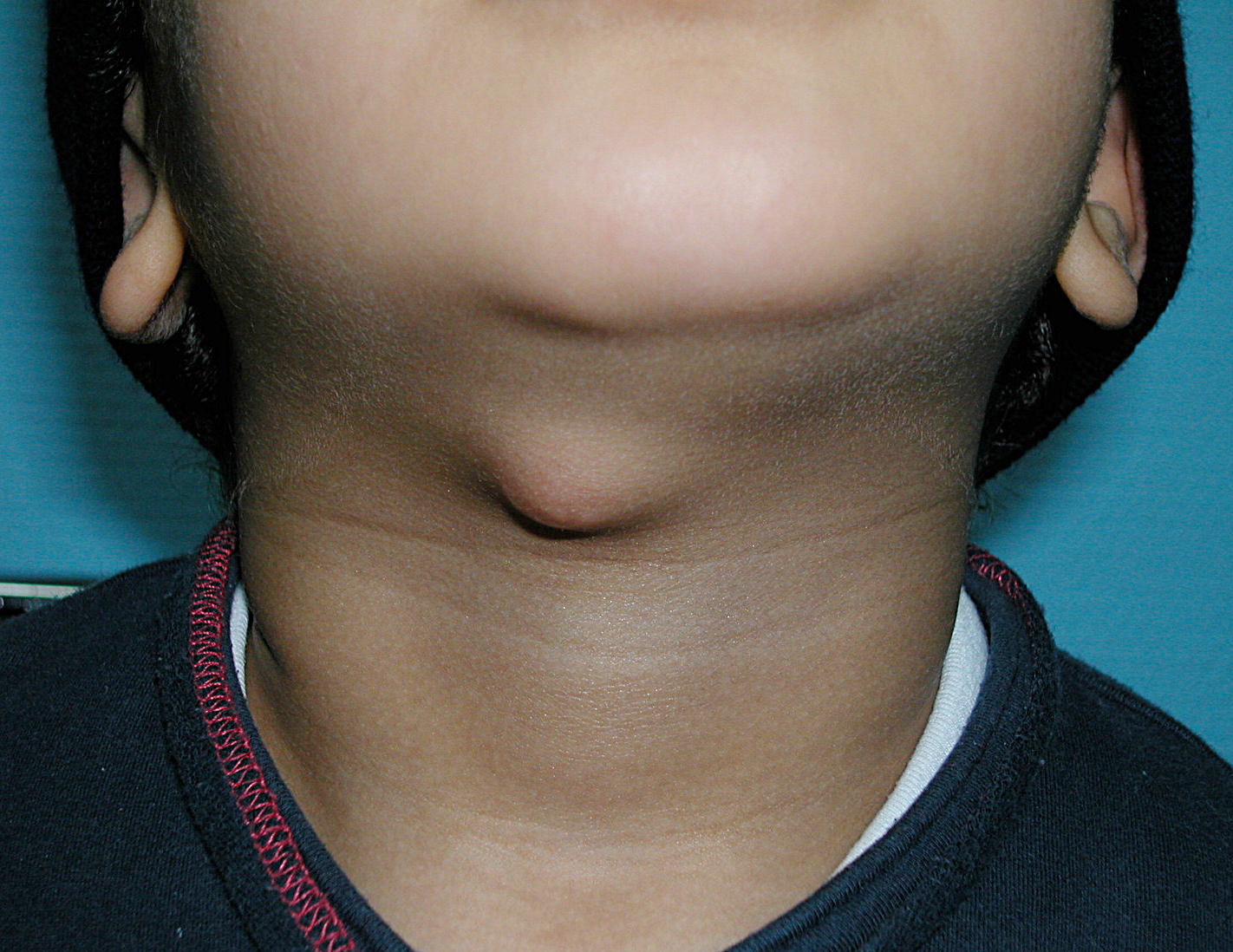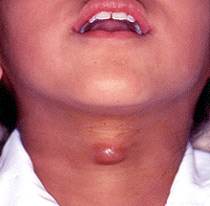Thyroglossal cyst
Cervical fistulae and cervical cysts are caused by failures of the viscera of the neck, so they are innate. A distinction median cervical cysts or fistulas on the midline of the neck of lateral ( side ) or branchial fistulas or cysts in the vicinity of the sternocleidomastoid muscle.
- 2.1 diagnostics
- 2.2 therapy
Median cervical cysts or fistulas
Median cervical cysts and fistulas arise from during embryonic non- educated parts of the thyroglossal duct. On the descent of the thyroid anlage from the ( subsequent) base of the tongue inferiorly creates a connection to the pharynx, the thyroglossal duct. Itself off this gear is not complete, so there remains a median neck cyst ( Bochdalek 's cyst ). Pauses in the context of an infection a median cervical cyst outwardly through, there is a median cervical fistula. Median cervical cysts are preferably formed in the region of the hyoid bone, as this probably is an obstacle on the way down. Here, the connecting passage can run along or drag through the hyoid bone through front or behind the hyoid bone.
Diagnostics
The median cervical cyst is usually palpated as a firm elastic swelling in the throat center. When swallowing, it shows an up and down motion. 75 % of cysts are diagnosed before the age of 6. In ultrasound, a fluid-filled cavity can be seen. A median cervical fistula is a small opening in the skin around the neck in the middle is, can escape from the dull, even purulent discharge.
Therapy
Due to the risk of infection with subsequent fistula formation, the cyst is surgically removed after diagnosis usually. It is also the possibly pendant fistula removed with the central portion of the hyoid bone (this recurrence rate below 5%, leaving 50 % for recurrences ). If present, the fistulous tract to the foramen cecum linguae should be (small pit at the base of the tongue ) followed and removed. Any existing Zungengrundstruma ( dystopes thyroid tissue ) may only be removed when a normal thyroid scintigraphy is detectable (otherwise is a lifelong hormone intake needed). Cyst is already infected, the infection must first be treated prior to the cyst is removed.
Lateral cervical cysts or fistulas
Lateral cervical cysts or cervical fistulae are remnants of the branchial arches or gill furrow, they are also called branchial cervical cysts or fistulas. The gill arch occur 4 to 8 weeks of embryonic development in the area of the pharynx intestine.
Most often remains a remnant of the second branchial arch. In the development of the neck of the second gill arch on the third and fourth growing. This results in a cavity, the cervical sinus, which usually disappears completely again later forms. This cavity forms not completely back, a gear or gear parts remain from the area of the tonsils through the neck soft tissues along the carotid artery to outward toward the skin, usually in the middle to lower third of the sternocleidomastoid muscle.
Diagnostics
The lateral cervical fistula falls through a small opening at the anterior border of the sternocleidomastoid muscle on the side of the neck, can flow from the milky or purulent discharge. Assigns the ( innate ) gear no skin opening to the outside on, can usually still in childhood or early adulthood relatively quickly caused by an inflammation of a firm elastic swelling, the lateral neck cyst, which seldom reach a size of about 5 cm. It can then be scanned before the sternocleidomastoid muscle and is usually clearly visible. Remnants of the other branchial arches appear as openings or swellings in the neck, jaw or cheek. In unclear cases, radiological examinations (CT, NMR) can help.
Therapy
As median cervical cysts should also consider the lateral cervical fistulae and cysts to undergo surgery because of the risk of infection.
Swell
- P. Puri and M. Höllwarth: Pediatric Surgery. Springer 2006, pp. 3-12
- Rudolf Probst, Gerhard Grevers, Heinrich Iro: Oto- Rhino-Laryngology. 3 revised. Edition 2008, ISBN 978-3-13-119033-8; pp. 290-292
- Brewis C, Mahadevan M, Bailey CM, Drake DP ( 2000): Investigation and treatment of thyroglossal cysts in children. Journal of the Royal Society of Medicine 93 (1): 18-21. PMID 10700841
- Disease in the ear, nose and throat medicine
- Disease in pediatric surgery
- Malformation







